There are a few more styles of Indian Painting which were not covered in the earlier posts. Am discussing them here:
Madhubani Painting
Pattachitra
Warli Painting
Phad Painting
Kalamkari
Pichwais
Manjusha Art
Mandana Painting
 Madhubani Painting
Madhubani Painting


Kalamkari Painting
Pichwais
Manjusha Art
Sources:
Madhubani Painting
Pattachitra
Warli Painting
Phad Painting
Kalamkari
Pichwais
Manjusha Art
Mandana Painting
 Madhubani Painting
Madhubani Painting
- Practiced in the Mithila region of Bihar.
- Done traditionally by the women of villages
- Painting is done with fingers, twigs, brushes, nib-pens, and matchsticks, using natural dyes and pigments,
- Characterized by eye-catching geometrical patterns.
- Traditionally done on freshly plastered mud walls and floors of huts, but now they are also done on cloth, hand-made paper and canvas.
- Madhubani paintings are made from the paste of powdered rice.
- There are paintings for each occasion and festival such as birth, holi, kali puja, etc
- Madhubani paintings mostly depict nature and Hindu religious motifs, and the themes generally revolve around Hindu deities
- Madhubani painting has received GI (Geographical Indication) status.
Pattachitra
- Traditional painting of Orissa, and as its name suggests is drawing on canvas (patta)
- Paintings are based on Hindu Mythology and specially inspired by Jagannath and Vaishnava cult.
- Paintings are done on small strips of cotton cloth. The canvas is prepared by coating the cloth with a mixture of chalk and gum made from tamarind seeds. Women traditionally make this gum and application.
- The master hand, mostly the male member, draws the initial line and gives the final finishing.
- The painting is held over a fire-place so that the back of the painting is exposed to heat. On the surface of the painting fine lacquer is applied.
- Natural colours are used.
- Tala Pattachitra is one variant of this form, drawn on palm leaf.
Warli Painting
- Warlis are an indigenous tribe living in hilly regions of Maharashtra-Gujarat border
- Warli Painting is mainly done on walls of houses. The walls are painted a red background and the painting is done only with white.
- It uses very shapes: a circle, a triangle and a square.The circle represents the sun and the moon, the triangle derived from mountains and pointed trees, the square indicates a sacred enclosure or a piece of land.
- The central motif in these ritual paintings is surrounded by scenes portraying hunting, fishing and farming, festivals and dances, trees and animals.
- Human and animal bodies are represented by two triangles joined at the tip; the upper triangle depicts the trunk and the lower triangle the pelvis. Their precarious equilibrium symbolizes the balance of the universe
Phad painting
- A popular style of folk painting practiced in Rajasthan.
- This style of painting is traditionally done on a long piece of cloth, known as phad which can be 15-30 feet in length.
- The narratives of the folk deities of Rajasthan, mostly of Pabuji and Devnarayan are depicted on the phads. The Bhopas, the priest-singers traditionally carry the painted phads along with them and use these as the mobile temples of the folk deities.
- These paintings have the mammoth task of representing a complex and a full blown folk epic narrative.
- Since they depict the different episodes, these paintings are customarily opened or unrolled only after sundown, in conjunction with the all night performance. This could be one reason for these paintings to be called Phad which means folds in Rajasthani dialect.


Kalamkari Painting
- Andhra Pradesh
- Technique of hand-painting of cloth using a bamboo pen- kalam. Black outlines of the pattern are painted on the cloth which are then filled with colours like red, green, ochre, blue etc.
- There are two distinctive styles of kalamkari art in India - the Srikalahasti style and Machalipatnam style.The Srikalahasti style of Kalamkari is entirely hand worked. This style flowered around temples and their patronage and so had an almost religious identity - scrolls, temple hangings etc depicted deities and scenes taken from the great Hindu epics.
- This style owes its present status to Smt. Kamaladevi Chattopadhayay who popularised the art as the first Chairperson of the All India Handicrafts Board.
- Only natural dyes are used.
Pichwais
- Nathdwara (Rajasthan) is the main centre to make these paintings.
- Pichwais mean 'at the back of', and these paintings are hung in the temples behind the deity.
- These were seasonal paintings but today they are painted through out the year.
- Painted pictures are of Lord Krishna along with his gopis. These paintings are also used to tell folk tales to the villagers.
Manjusha Art
- Practiced in Bhagalpur, Bihar.
- Its a local art derived from a very popular folk tale of Bhagalpur namely `Bihula-Vishahari Gatha'. The tale is that of Bihula who saved her husband from the deity’s wrath and a snake-bite and also of Bishahari or Mansa, the snake goddess known for her anger when displeased but also her fierce protectiveness when propitiated.
- Manjushas are temple-shaped boxes which contain paintings of Gods and Goddesses.
- They are made of bamboo,jute and paper.
- These boxes are used in Bishahari puja -a festival dedicated to Snake God


Mandana Painting


- Practiced in eastern Rajasthan
- Mandana are painted on walls and homes.drawn to protect home and hearth, welcome gods into the house and as mark of celebrations on festive occasions.
- Practiced exclusively by women
- Designs of perfect symmetry and accuracy are produced.
- Lime or Chalk powder is used for making the motif.


Sources:
http://phadchitrakari.com/phadchitrakari/aboutphad.htm
http://www.culturopedia.com/Painting/folkpainting.html
http://www.craftandartisans.com/pichwais-of-rajasthan.html
http://en.wikipedia.org/wiki/Mandana_Paintings
http://indianartscene.blogspot.in/2007/04/expression-of-joy-mandana-painting.html
http://www.creativityofmeenas.org/Mandanaanartform.htm
http://www.culturopedia.com/Painting/folkpainting.html
http://www.craftandartisans.com/pichwais-of-rajasthan.html
http://en.wikipedia.org/wiki/Mandana_Paintings
http://indianartscene.blogspot.in/2007/04/expression-of-joy-mandana-painting.html
http://www.creativityofmeenas.org/Mandanaanartform.htm

Superb Article Maam.. Loved reading.. There is so much to learn from our own culture.. Thankx for posting such a valuable information.
ReplyDelete